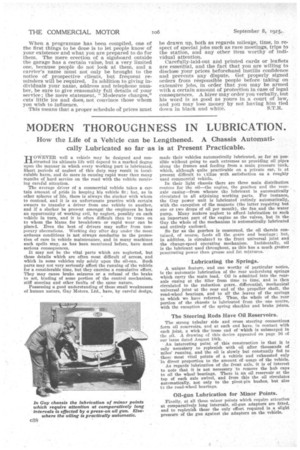MODERN THOROUGHNESS IN LUBRICATION.
Page 22

If you've noticed an error in this article please click here to report it so we can fix it.
How the Life of a Vehicle can be Lengthened. A Chassis Automatically Lubricated so far as is at Present Practicable.
J'owEvErt well a vehicle may be designed and constructed its ultimate life will depend to a marked degree upon the manner in which every working part is lubricated. Short periods of neglect of this duty. may result in incalculable harm, and do more in causing rapid wear than many months of hard service on the road with the vehicle receiving careful attention.
The average driver of a commercial vehicle takes a certain amount of pride in keeping his vehicle fit ; but, as in other spheres of life, there is always the slacker with whom to contend, and it is an unfortunate practice with certain owners to transfer a driver from one vehicle to another, and if a slacker be present amongst the employees he has an opportunity of working evil, by neglect, possibly on each vehicle in turn, and it is often difficult then to trace on to whom the blame for breakdown or rapid wear can be placed. Even the hest of drivers may suffer from temporary aberrations. Working day after day under the most arduous conditions is not always conducive to the promotion of care in vehicle maintenance, and in many machines such spells may, as has been mentioned before, have most serious consequences.
It may not be the vital parts which are neglected, but those details which are often most difficult of access, and which in some vehicles rely solely upon the oil-can. Such parts may not very seriously affect the running of the vehicle for a considerable time, but they exercise a cumulative effect. They may cause brake seizures or a refusal of the brake to act, binding of some portion of the control mechanism, stiff steering and other faults of the same nature.
Possessing a good understanding of these small weaknesses of human nature, Guy Motors, Ltd., have, by careful design, made their vehicles automatically lubricated, so far 'as possible without going to such extremes as providing oil pipes along the frames and feeding from a main pressure tank, which, although quite practicable on a private car, is at Present difficult to itilize with satisfaction on a roughly used commercial vehicle.
In their light chassis there are three main distribution centres for the oil—the engine, the gearbox and the rearaxle` casing—from whence the lubricant is automatically circulated to all adjoining working parts. For instance, the Guy power unit is lubricated entirely automatically, with the exception of the magneto (the latter requiring but one or two drops of oil per month), the fan and the water pump. Many makers neglect to afford lubrication to each an important part of the engine as the valves, but in the Guy the whole of the mechanism is automatically lubricated and entirely enclosed.
So far as the gearbox is concerned, the oil therein contained, of course, feeds all the gears and bearings; but, in addition, is circulatei to the front universal joint and the change-speed operating mechanism. Incidentally, oil is the lubricant used throughout, as this has a much greater penetrating posvcr than grease and fat mixtures.
Lubricating the Springs.
A unique feature, and one worthy of particular notice, is the automatic lubrication of the rear underslung springs which carry the main load. Oil is admitted into the rearaxle casing at the filler from time to time, and is then circulated to the reduction gears, differential, mechanical universal joint-at the rear end of the propeller shaft, the road-wheel bearings, and to all the leaves of the springs to which we have referred. Thus, the whole of the rear portion of the chassis is lubricated from the one centre, with the exception of the spring shackles and brake joints.
The Steering Rods Have Oil Reservoirs. .
The strong tubular side and cross steering connections form oil reservoirs, and at each end have, in contact with each joint, a wick the' loose end of 'which is submerged in the oil. A drawing of this device appeared on page 16 of our issue dated August 18th.
An interesting point of this construction is that it is only necessary to replenish with oil after thousands of miles' running, and the, oil is slowly but constantly fed to these most vital points of a vehicle and exhausted only in direct proportion to the amount of usage of the vehicle. As regards lubrication of the front axle, it is of interest to note that it is not necessary to remove the hub caps to oil the wheel bearings. There is an oil reservoir at the top of each axle swivel, and from this the oil circulates automatically, not only to the pivot-pin bushes, but also to the road-wheel bearings.






























